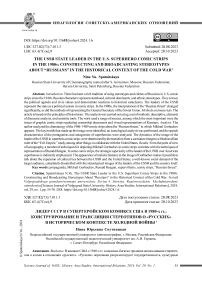The USSR state leader in the U.S. superhero comic strips in the 1980s: constructing and broadcasting stereotypes about “Russians” in the historical context of the cold war
Автор: Sputnitskaya N.Yu.
Журнал: Вестник ВолГУ. Серия: История. Регионоведение. Международные отношения @hfrir-jvolsu
Рубрика: Имагология советско-американских отношений в период Холодной войны
Статья в выпуске: 1 т.29, 2024 года.
Бесплатный доступ
Introduction. There has been a rich tradition of using stereotypes and cliches of Russians in U.S. comic strips since the 1940s. Russian characters represent statehood, cultural dominants, and ethnic stereotypes. They convey the political agenda and civic values and demonstrate reactions to historical cataclysms. The leaders of the USSR represent the state as a political system in comic strips. In the 1980s, the interpretation of the “Russian threat” changed significantly, as did the methods of representing the General Secretary of the Soviet Union. Methods and materials . The article is based on the principles of historicism. The analysis was carried out using a set of methods: descriptive, elements of discourse analysis, and semiotic tools. The work used a range of sources, among which the most important were the issues of graphic comic strips regulating censorship documents and visual representations of Russians. Analysis. The author analyzed the dramaturgy of the 1986-1989 comic strips about the “Russian threat,” in which Mikhail Gorbachev appears. The key motifs that made up the image were identified, an iconological analysis was performed, and the speech characteristics of the protagonists and antagonists of superheroics were analyzed. The dynamics of the image of the leader of the USSR in superhero comic strips were determined by the transition from a caricature image to a Machiavellian ruler of the “Evil Empire,” ready, among other things, to collaborate with the United States.
Propaganda, mikhail gorbachev, ronald reagan, supervillains, comic strips, “russian threat”
Короткий адрес: https://sciup.org/149145124
IDR: 149145124 | УДК: 327.82(73):7.011.3 | DOI: 10.15688/jvolsu4.2024.1.6
Текст научной статьи The USSR state leader in the U.S. superhero comic strips in the 1980s: constructing and broadcasting stereotypes about “Russians” in the historical context of the cold war
DOI:
Цитирование. Спутницкая Н. Ю. Лидер СССР в супергеройском комиксе США в 1980-х гг.: конструирование и трансляция стереотипов о «русских» в историческом контексте холодной войны // Вестник Волгоградского государственного университета. Серия 4, История. Регионоведение. Международные отношения. – 2024. – Т. 29, № 1. – С. 55–76. – (На англ. яз.). – DOI:
Introduction. The urgency of the study is due to the historical tradition of using stereotypical “Russian” in U.S. propaganda characters that represent statehood, cultural dominants, ethnic stereotypes, convey political agendas and civic values, and demonstrate reactions to historical cataclysms. The analysis of “Russian” images in comic books, and in particular the political leader of the USSR during a certain period, will make it possible to study the dynamics of the construction of “Russian” characters in mass culture. Thanks to it, it is possible to identify effective technologies for transmitting stereotypes about the USSR and Russia in modern media, including cinema, TV (news broadcasts, television series, etc.), and new media (publications on the Internet, social networks, etc.). Until today, the analysis of the image of the General Secretary of the USSR, Mikhail Gorbachev, in the superhero comic has not been made. The superhero comic, as a tool of public policy, has evolved over time, responding to various pressing demands from both U.S. society and government. The direct control of the industry by the state is evidenced by the FBI archives (in particular, the Correspondence of President of the Association John Goldwater, which is mentioned by comic books researchers G. Morrison, J. Dittmer, and S. Krensky [3; 13; 17]). In his research, P.S. Hirsch detailed how, in the 20th century, the American government and social organizations defined the form and content of the comic [9]. In turn, Soviet and Eastern European animation is full of allusions and critical assessments of U.S. comic book images [23; 24; 30]. Historical characters play a separate role in artistic propaganda [12; 26; 30].
The tradition of introducing the USSR leader as a representative of a rival power into the serial narrative emerged in the 1940s and was strengthened during the escalation of the Cuban Missile Crisis. In the 1970s, interest in finding original representations waned, but in the 1980s, the relevance of “Russian” characters increased again. The space for experimentation in comic books was born from the foreign policy situation (the need to design the enemy in an acute situation), the rhetoric, and even the personality of the U.S. president. If the duo “Khrushchev-Kennedy” effectively implemented the model of the old – young head of the country, then after the 1960s there was a crisis in the representation of such opposition [4; 22; 26]. A conditional communist cumulatively replaced the caricature of the Soviet political leader (this is evident in the example of the dynamics of the image of Khrushchev in the comics Marvel published in 1961–1963). It should be noted that it is more difficult to make this type of character expressive for the audience than the figure of a monster or an alien. At the same time, the state order required authors to introduce “Russian” characters to construct an external enemy [25; 28; 30].
By the mid-1960s, a stable set of types of “Russian” characters had formed in the superhero comics. The authors are limited to a cheap set of tools and attributes that make the image recognizable and spectacular: a red five-pointed star, a bald skull, tattoos, a leather jacket, worn pants, a beard, and a mustache. The color palette of “Russian” suits is limited; it is dominated by combinations of green and red. In comic books and other texts of mass culture from the 1970s, the KGB is personified (in particular, in Bondiana films). The first, rather timid attempts by the creators of Marvel to introduce the superhero President of the United States, John Fitzgerald Kennedy, as a character did not have time to form a tradition. His representations had only an iconographic similarity to the prototype and, unlike the image of Nikita Khrushchev, had no development.
By the Détente period, the Russian characters in the comic had become irrelevant; the communists had turned out to be alien beings or representatives of other countries and ethnic groups. All this was a consequence of the “growing concern about the moral certainty of the Cold War American identity” [2, p. 94]. In this context, the biographies of former supervillains Sergei Kravinoff and Dmitri Smerdyakov (Chameleon) were specified, and a new “Russian” character, Leonid Kovar (Red Star), was constructed. The meager and less divisive episodes of Richard Nixon in superhero storylines bore witness to the looming crisis in the 1970s [27]. Leonid Brezhnev’s appearances in the comic book were episodic and dated from 1981; he appeared in the “group” of politicians, whose countries were under worldwide threat from the outside. Among them, the reader only met the incoming head of the United States, Ronald Reagan, whose copyright position was neutral. By the mid-1980s, however, against the backdrop of the confrontation and dialogue between Reagan and Gorbachev, which developed in the pages of the superhero comic book, heads of state blended into the fabulous discourse as comic characters, both kinematic and controversial.
Transmedia narrative researchers, referring to the tools of semiotics and cognitive analysis [14; 18; 27], have been examining how the comic conveys topics such as cultural imperialism, the Pharmakon image, hegemonic masculinity, and sovereignty. Dittmer discovers that it is the design of the character Captain America that becomes one of the reasons for the capacity and mobility of the image; it explains the empathy of the audience and the functionality of a very conditional character [3, p. 642]. The analytical strategy of the researcher seems to be effective in relation to the comic versions of the leader of the USSR because it reveals the mechanisms of criticism of friend and foe in the period of “tension” [19]. The position that the Superhero comic is based on the laws of the heroic (magical) fairy tale [5; 16] and the provision of the comic book as a consistent art, which the researcher S. McCloud postulates [15], the narrative of the Russian threat and the image of the USSR leader in the Cold War comic book can be analyzed by searching for a mechanism to complete the image of the “Russian threat” between frames and iconographic and verbal components of the image.
The analysis of composition, perspective, gluing, flying, replica, and logic of the order of frames provides additional material for characterizing the image of the “Russian” enemy. The Reagan era saw an intense search for techniques and ways to build narratives, including critical assessments of the head of state. This was due to factors external to the subculture of comics and internal processes. The Comics Code Authority (CCA), the launch of high-priced comic book titles and video and film competitions after New Hollywood [25], became the impetus for expressive media: layout, rhythm, and story dynamics. The selected research focus makes it possible to: understand and evaluate the functions of the Soviet political leader in comics; establish the dynamics of the formation of a positive image of Russians in mass culture; and identify a set of artistic techniques (elements of mythology) for creating an image of political leadership. To do this, it is necessary to analyze the dynamics of the image of the General Secretary of the USSR in the Superhero comics of 1986–1989.
Methods and materials. The analysis of the comic book in chronological order makes it possible to establish a sequence of cultural connections between the existing political, social, and cultural agendas of the United States and the USSR and their implementation in graphic images. The historical value of the graphic comic book about superheroes lies in the special cultural significance of the visual component, which allows for propaganda, education, entertainment, and other tasks. The analysis is carried out using a complex of methods: the descriptive method, elements of discourse analysis, and tools of semiotics. The research used a range of sources, among which the most important are: the issues of graphic comics; regulating censorship documents; and visual representations of “Russian” characters.
Analysis. The 1980s for the comic book industry and for the major producers in the DC and Marvel industries were characterized by a significant difference in audience and a change in age. In DC comics, in particular, there were much more complex stories; the characters were grouped together; and a specific literary drama and psychological depth were registered (first of all, in the Batman comics).
By the 1980s, the USSR was represented primarily by stable, widely known target audience locations and spaces in DC and Marvel comics (the Kremlin, Siberia, and other places that made it possible to unambiguously identify the country). At the same time, interest in the complexity of conflicts and plots leads to the emergence of ambiguous character traits (this applies to both superheroes and known, for example, political personalities). It is quite natural that, in addition to the traditional confrontation between the USSR and the USA, inherited from the previous decades of the Cold War, the motive of the growing threat from third parties – the antagonists who do not represent the USSR, the USA, or, often, the inhabitants of Earth – gains importance.
In the issue The Adventures of Superman [1], the USSR and the USA are threatened by Dr. Stratos, who, like Superman, is not human, though anthropomorphic. Like Superman, he does not know his parents (they are the gods who left his son at the foot of Mount Olympus after his birth). The completely clichйd plot of the comic book is that Stratos seeks world dominance using his supernatural ability to control the weather. In the comic book exposition, he addresses Reagan and Gorbachev directly by telephone, demanding nothing and merely announcing that both superpowers will be conquered. The image of the head of state in the comic book exposition is presented in an iconographically authentic way; the similarity is easy to perceive. With regard to the speech characteristics, it should be noted that the style of communication between them is, if not between friends, then between colleagues (Reagan refers to Gorbachev by name). Moreover, at the end of an abusive conversation with Stratos’ threats, the President of the United States clearly hints that he has a man who can help both countries: Superman.
The 1986 DC comics series The Outsiders is a reaction to the difficult period of the Cold War, where there was no previous polarization of left and right forces, good and evil. Characters can change sides; numerous hero alliances are temporary and much less stable than the famous superhero associations Avengers (Marvel) or Justice League (DC). In particular, the group “Outsiders” arises as a squad of Batman’s assistants, created with his direct participation, but in the future it will begin to develop as an independent group of superheroes. It should be noted that one of the signs of the drama of DC and Marvel comics is manifested in the fact that not anthropomorphic beings (of extraterrestrial origin, such as Superman, or those associated with the literary and mythological layer – Aquaman, Thor, Wonder Woman), but people with superpowers are becoming increasingly important among superheroes. Thus, in the “Outsiders” squad, the character Looker (Emily “Lia” Briggs) has psychotelekinesis, the character Geo-Force (Brion Markov) has superhuman strength and speed, etc.
In the exposition of the comic The Outsiders. Pawns of the Bad Samaritan [20], a former Soviet spy, the Bad Samaritan, offers a deal to General Secretary Gorbachev. It becomes known from the dialog that the USSR and Gorbachev are directly connected with the events of another issue of The Outsiders , where the fictional East-European country Markovia, where the USSR supported an attempt to change the political regime (allusions to the post-war redistribution of the world, the creation of the countries of the Warsaw Pact, the partition of Germany, and other political conflicts of the Cold War). The Bad Samaritan promises to improve the economic situation of the USSR and help strengthen the political position of Gorbachev himself (according to the plot, the Bad Samaritan will steal the forms and plates for printing Markovia banknotes to achieve economic collapse). The relationship between the characters changes dramatically from the beginning to the end of the scene, from the relationship between the Angry Customer and the Failed Performer to a friendly conversation between the two business partners.
In depicting Gorbachev, the painters clearly did not seek iconographic similarities with the politician. Only the birthmark on his forehead can be attributed to the General Secretary. The space in which the scene takes place – Gorbachev’s office in the Kremlin – is sketchy and consists of visual clichés borrowed from comics, literature, and cinema of the past years: a portrait of Lenin on the wall, carved heavy ceilings of the Kremlin corridor, a lamp with a lampshade, a massive desk, expressionist lighting, that is, a combination of drawing light and dark background, and so on. A conversation about rising inflation and problems with bread in Russia is given against the background of the image of an old man with an avoska (a net bag), standing in front of a wooden apartment building with the Kremlin in the background (Fig. 1).
However, it must be understood that the storyline between Gorbachev/Kremlin and The Bad Samaritan is not the primary focus, but it is necessary to realize the central plot: a spectacular, expressive conflict between two groups of Outsider superheroes (patriots of Markovia) and the Force of July (that is, a governmental unit of superheroes from the USA).
The story continues in the next issue of the comic [21]. Quite characteristic of the DC comics of the 1980s is the unexpected denouement and finale: the operation to steal typographic bank forms ordered by Gorbachev to the Bad Samaritan turned out to be just a spy check. In the finale, the head of the USSR personally returns the forms to Major Victory and offers the Bad Samaritan to head the service for recruiting and training Soviet secret agents. In addition to the original conflict, it is interesting how Gorbachev is dramaturgically (at the level of dialog content) and visually presented (Fig. 2).
The General Secretary of the USSR is presented as an experienced strategist. His speech is characterized by conciseness and the ability to make judgments that have the force of an unconditional order for superheroes from other countries (Fig. 3). The finale is indicative. In the midst of a battle between Soviet troops, the Force of July, and Outsiders, Gorbachev spectacularly appears with a sacramental phrase: “Forgive the melodrama... But I had to get you attention / I believe you are seeking these?”
After handing over the clichés, Major Victory wonderfully asks, “What’s this, some kind of commie trick?”. This exchange undoubtedly emphasizes that the American Hero Major Victory does not distinguish between rhetorical discourses and is unable to enter any elementary negotiations. He uses the rough, colloquial word “commie” to refer to the political leader of a foreign country, which is obviously impossible in such a delicate situation. Moreover, Major Victory is a largely caricatured figure: a blond, serviceman, possessing enormous power, who is able to fly, understands and gives only direct orders, and who is rather anachronistic and typical of 1960s comics. He is, in a sense, the quintessence of American fears and hatred of communists and the Soviet era at the height of the Cold War. On the same page of the comic book, after seeing the General Secretary for the first time, Major Victory exclaims, “Gorbachev! If I could kill him...”. The absurdity of this statement, especially from the leader of the group representing U.S. interests, is understood even by the leader of the Outsiders: “There would be war. Keep still,” says Geo-Force. However, Gorbachev skips the insult and replies aphoristically, “No, not a trick. The collapse of America’s economy would be desirable, but the world’s would soon follow – and that would not”.
Of particular interest is a series of images following the images considered. It is curious that the American group of superheroes, Force of July, having received bank clichйs, immediately flew away without even trying to request the extradition of the spy of the Bad Samaritan or accuse him of crimes against civilians. Geo-Force, a person who is completely uninterested and who is not a U.S. citizen, has again taken over this function. He says, “But this man murdered an American citizen, he...” Gorbachev’s polite phrase, “You may leave,” stops further attempts at negotiations. The final image is also of interest: in the foreground there are the figures of Gorbachev and the Bad Samaritan in a typical cinematic mise en scene (two characters are deployed three-quarters mirrored to each other). Gorbachev is shown from the bottom point, with emphasized monumentality; the Bad Samaritan is also presented advantageously – only his expressive profile is visible. On the other hand, the right part of the image (the colored figures flying in the right part of the frame resemble the artists of the tent show in their graphic and color diversity) looks absurd since it does not correspond stylistically to the main tonal and compositional character of the frame, referring to the aesthetics of noir, the political thriller of the 1960s and 1970s [28, pp. 195, 325].
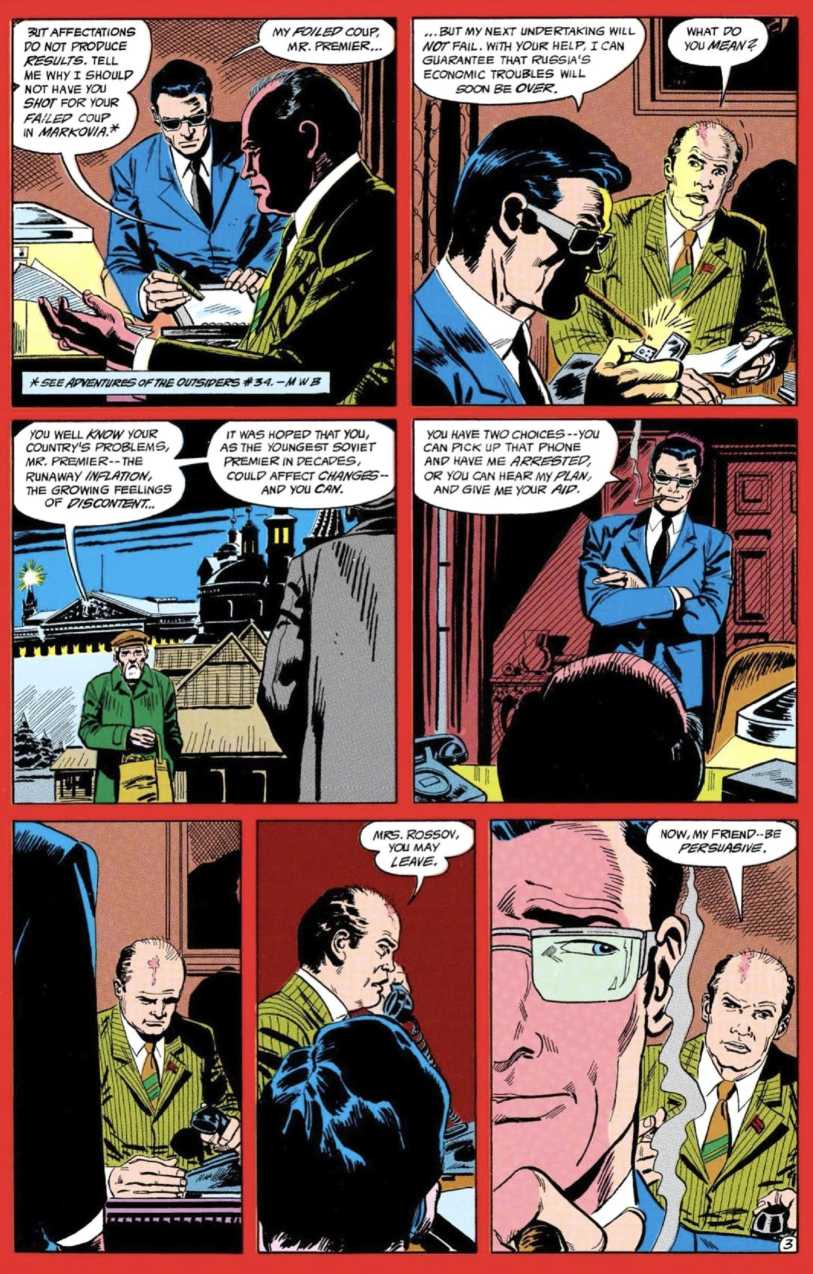
Fig. 1. Frame from the comic book
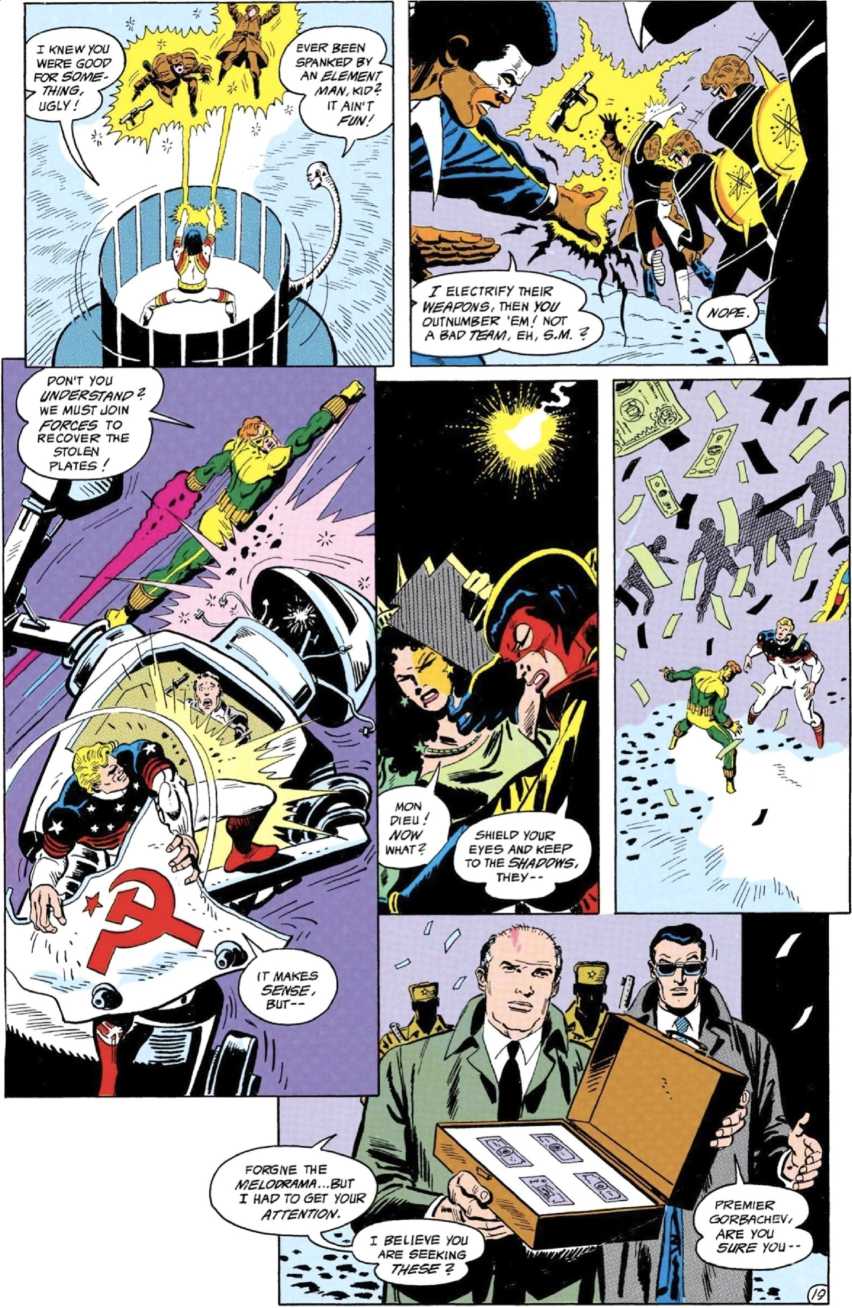
Fig. 2. Frame from the comic book
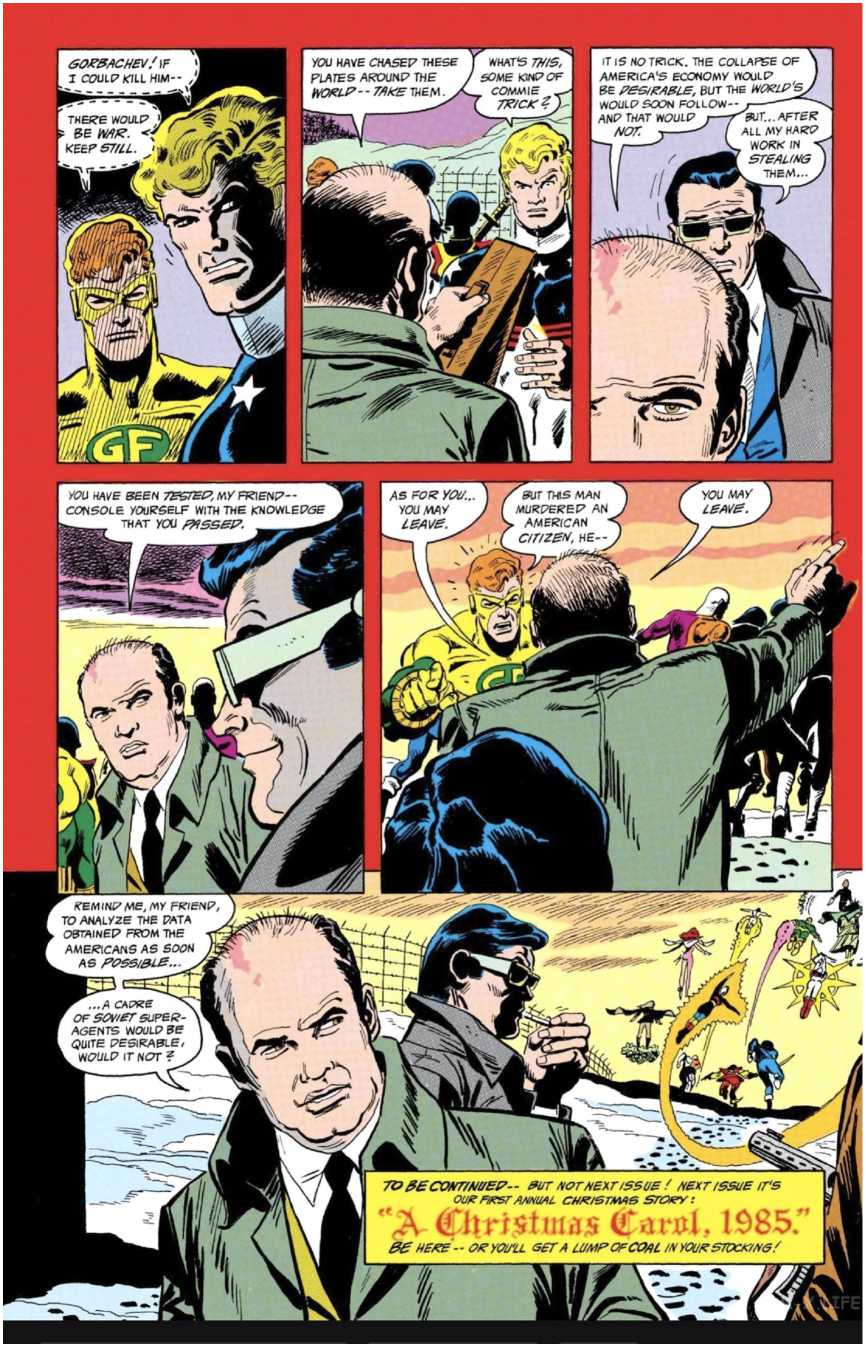
Fig. 3. Frame from the comic book
Thus, the entire political adventure with the theft of clichés represents a complex, multidirectional combination of verification and actual recruitment of a valuable Bad Samaritan superspy. In such a situation, Gorbachev is presented not only as a talented strategist and an experienced politician but also as a leader capable of making tough decisions. One of the stages of the operation is the landing of the Bad Samaritan with a cliché on a Soviet submarine. Again, despite the apparent physical superiority of the Force of July, Soviet sailors managed to defeat them due to their well-organized work. Additionally, the entire American group, including the Victory Major, finds themselves in Soviet captivity, where they are experimented on at a special facility near Leningrad.
In the same year, the series The Outsiders further developed the theme of the USSR and Gorbachev. In the issue Is No More the Outsiders, Is Just the People’s Heroes [11], the plot is based on the abduction of the wife of the American black superhero Black Lightning (Fig. 4). The first pages reveal that the dictator of the African state of Mozambia is in direct contact with the USSR and Gorbachev. The Outsiders embark on a rescue mission that turns out to be a trap, as the General Secretary of the USSR has sent a group of his own superheroes to Mozambia. The exposition in several images shows a telephone conversation between the dictator and Gorbachev, who, having learned that the Outsiders are planning to arrive in Africa, takes the opportunity to settle scores. The interests of the USSR in this situation are purely economic, since Mozambia is the source of the American currency. Indeed, Soviet superheroes have taken all the Outsiders captive, with the exception of Black Lightning. However, the attributes of the characters and their names are Cold War clichйs. Thus, among the Soviet superheroes are: a married couple, Hammer and Sickle (both spouses have superhuman strength and combat skills); Molotov, a specialist in organizing explosions; and a female character named Pravda with telepathic abilities. Costumes and other elements of the appearance are also quite stenciled: large red stars applied to clothes on the chest, emblems of “USSR” on belts, and elements of military style in clothing.
The story from the reviewed issue is further developed in the comic book The Outsiders... and The Rockets’ Red Glare [22]. The Looker says that the dictator of Mozambia eventually sent the Soviet superheroes to prison as well. However, they were rescued from prison by another group of Soviet superheroes: three characters who, due to nuclear fusion, are able to unite into one superhero, Fusion (Fig. 5).
The conflict of the plot is communicated to the Soviet superheroes directly by Gorbachev: “But our doctors seem to think the fusing process may have unbalanced his personalities, tripling not only his love of country – but his hatred for her foes.” Fusion is mentally unstable and, ultimately, too dangerous for the USSR in a difficult geopolitical environment. He plans to carry out an attack and sabotage the reopening of the Statue of Liberty. The deaths of any official at the event could be a cause for war. Gorbachev stresses that the aggravation of relations between the Soviet Union and the United States is unacceptable, and the elimination of Fusion will become a joint operation of the Soviet superheroes and the American Group Force of July.
The superheroes of the USSR are strictly subordinate to the General Secretary. In the image, the squad is lined up in front of Gorbachev in his Kremlin office. It is important to note that the chosen perspective (the general plan, the unit standing frontally in front of the Secretary General, who has his back turned to the viewer) emphasizes not so much the personal importance of the leader but rather, apparently, the Russians’ abiding by the very fact of subordination. Psychologism and the depth of connections between characters – a characteristic feature of 1980s comics – is achieved through the capacity of the lines. The heroine Pravda is quite free to give Gorbachev her expert opinion (she is a telepath and synesthetic) about the unprofitability of Fusion: “Fusion must be stopped. I sensed great mental anguish in him,” which only confirms the Kremlin’s decision. That is, there is no blind obedience in the group of Soviet heroes, which, for example, was conveyed in the 1950s in literature, in particular, in Fleming’s novel From Russia with Love , where the management models of SMERSH and MI6 were opposed precisely by the criterion of dialog between the leadership and the performer (Politburo/Rosa Klebb-Grant, “M”-Bond). Gorbachev, when he expresses the decision of the Politburo about Fusion, is shown against the backdrop of the Fusion close-up, which is undoubtedly a cinematic clichй (for example, the texture is a frame from the film Citizen Kane , Fig. 6).
A similar technique is used in the 1983 Bond film Octopussy (Fig. 7).
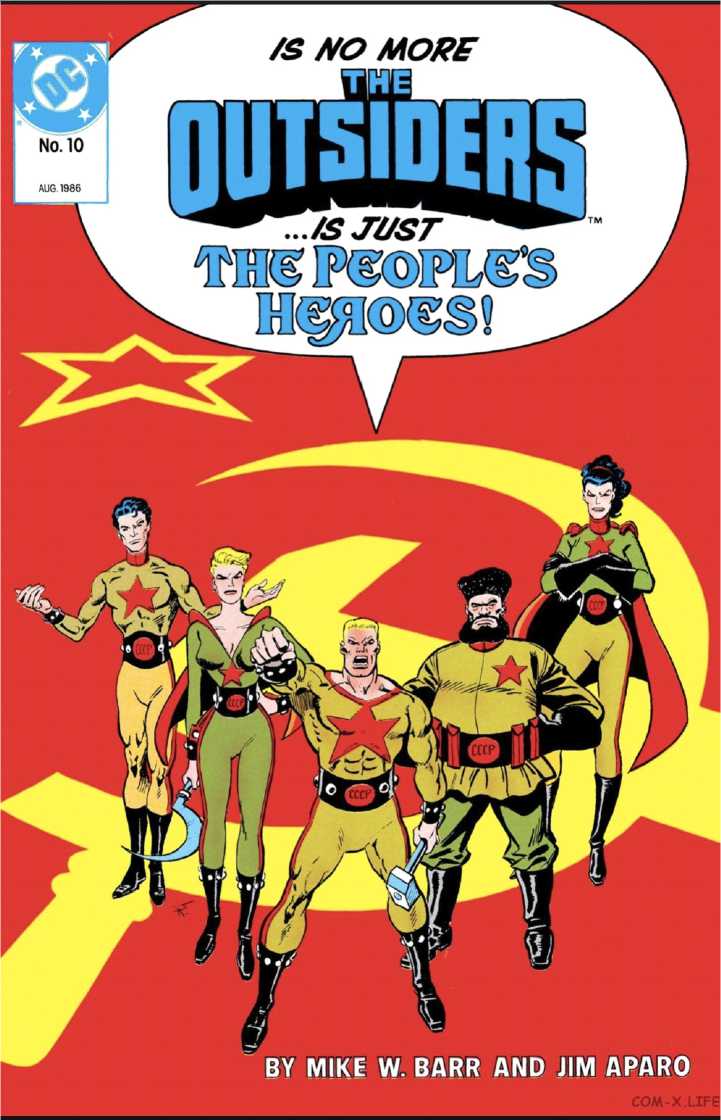
Fig. 4. Frame from the comic book
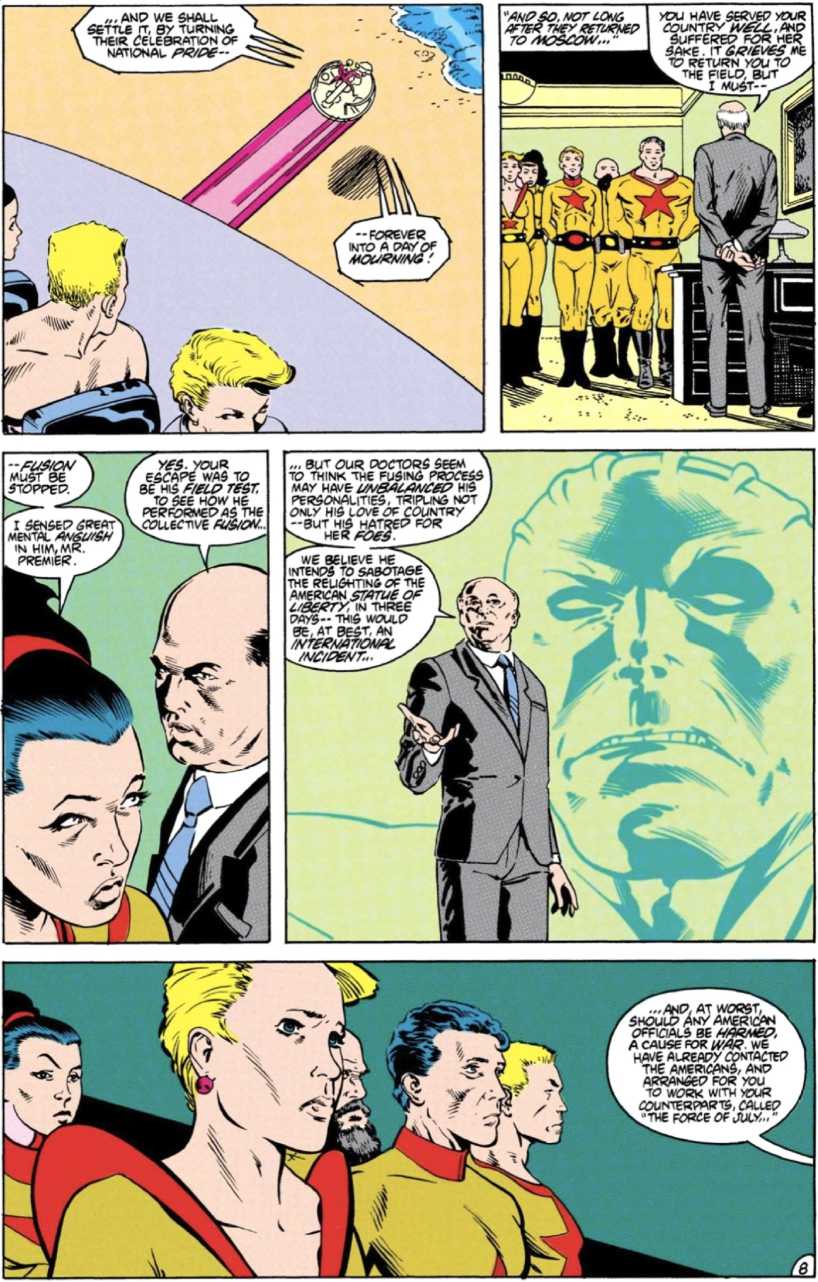
Fig. 5. Frame from the comic book
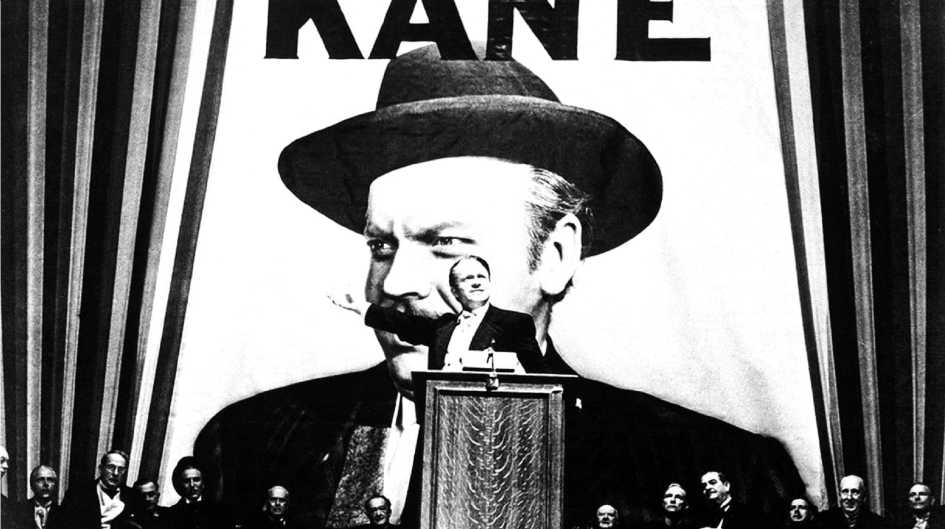
Fig. 6. Frame from the film the movie “Citizen Kane” (1941)
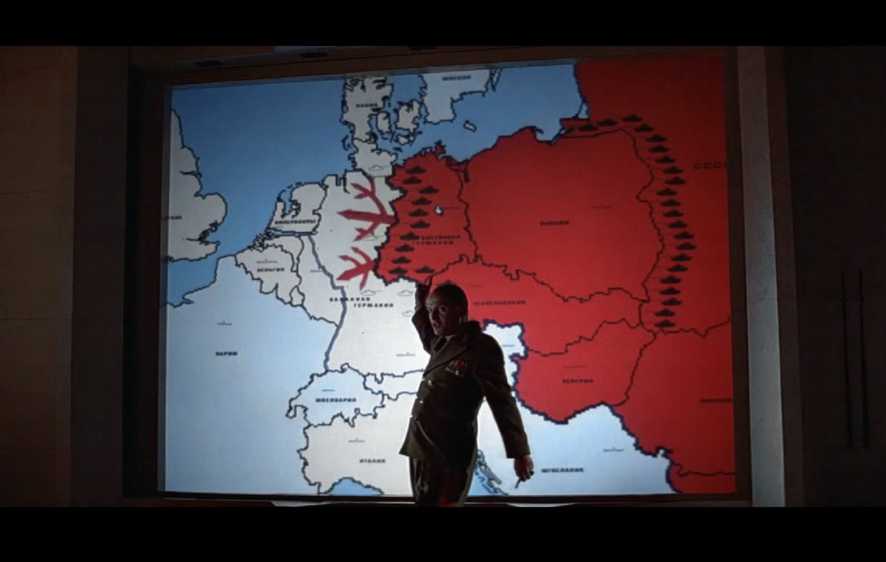
Fig. 7. Frame from the film “Octopussy” (1983)
The model of subordination of Soviet superheroes to Gorbachev is generally identical to the Force of July model, but with one important difference. The author’s irony can be seen in the fact that the General Secretary of the USSR discusses the joint operation of superheroes not with the American president (such a motive is also implemented in the comics of the 1980s), but with Blairman, Director of the American Security Agency and creator of the Force of July. Blairman is a typical character: the head of the secret service, to whom special agents personally report on completed tasks. Among his functions, this clichйd character inherited from the comics and films of the 1950s and 1960s such a characteristic element as distrust and hatred of communists, but unlike Victory Major, Blairman, at least nominally, accepts the rhetoric of cooperation. While ordering a joint operation with the USSR, he nevertheless orders: “...And you are assigned to work with them to find this alleged ‘renegade’. But keep an eye on them. I don’t trust them any further than I can throw them!”. At the same time, Gorbachev, unlike Blairman, does not give his superteam any additional orders in relation to their colleagues (Fig. 8).
Images of the Soviet Union and Gorbachev appeared in such an extensive series of comics of the 1980s as The Green Lantern Corps , released by DC since 1959. This series developed the idea of many inhabited worlds populated by intelligent beings, but not always humanoids. The Green Lantern Corps was an association of the best representatives of the planets that ensured world order with the help of the power rings given to its members. In the release The Green Lantern Corps [7], one of the superheroes, Salakk, formulated the credo of this alliance: “We are all here to protect life”.
The further development of the plot is solved in a similar way – through the manipulation of motifs and clichés from anti-Soviet comics and films of the past. At the same time, “nine hundred miles in the Atlantic Ocean,” a Soviet spy persuades one of the green lanterns, Kilowog, from the planet Bolovax Vik, to visit the Soviet Union. The scout briefly explains to the alien the geopolitical situation on planet Earth: there are two systems – the Western (USA), where money and individualism rule, and the Eastern (USSR), where everyone is equal and good and collective rule. The alien wants to make sure of this immediately and goes to a meeting with Gorbachev. Later, two other green lanterns, John and Katma, became interested in the Soviet system.
The plot and its development in Nos. 208– 210 are also interesting as an example of the transformation of the anti-Soviet propaganda rhetoric of the past years into spectacular, entertaining material. The story is constructed in such a way that the viewer, observing the actions of the characters, thanks to the dialogs, gets the opportunity to ascertain the viciousness of the Soviet system and the scheming of Russians. As a result, the Green Lanterns unwittingly split into two camps: Kilowog, who becomes a communist, and members of the core group, who seek to convince him.
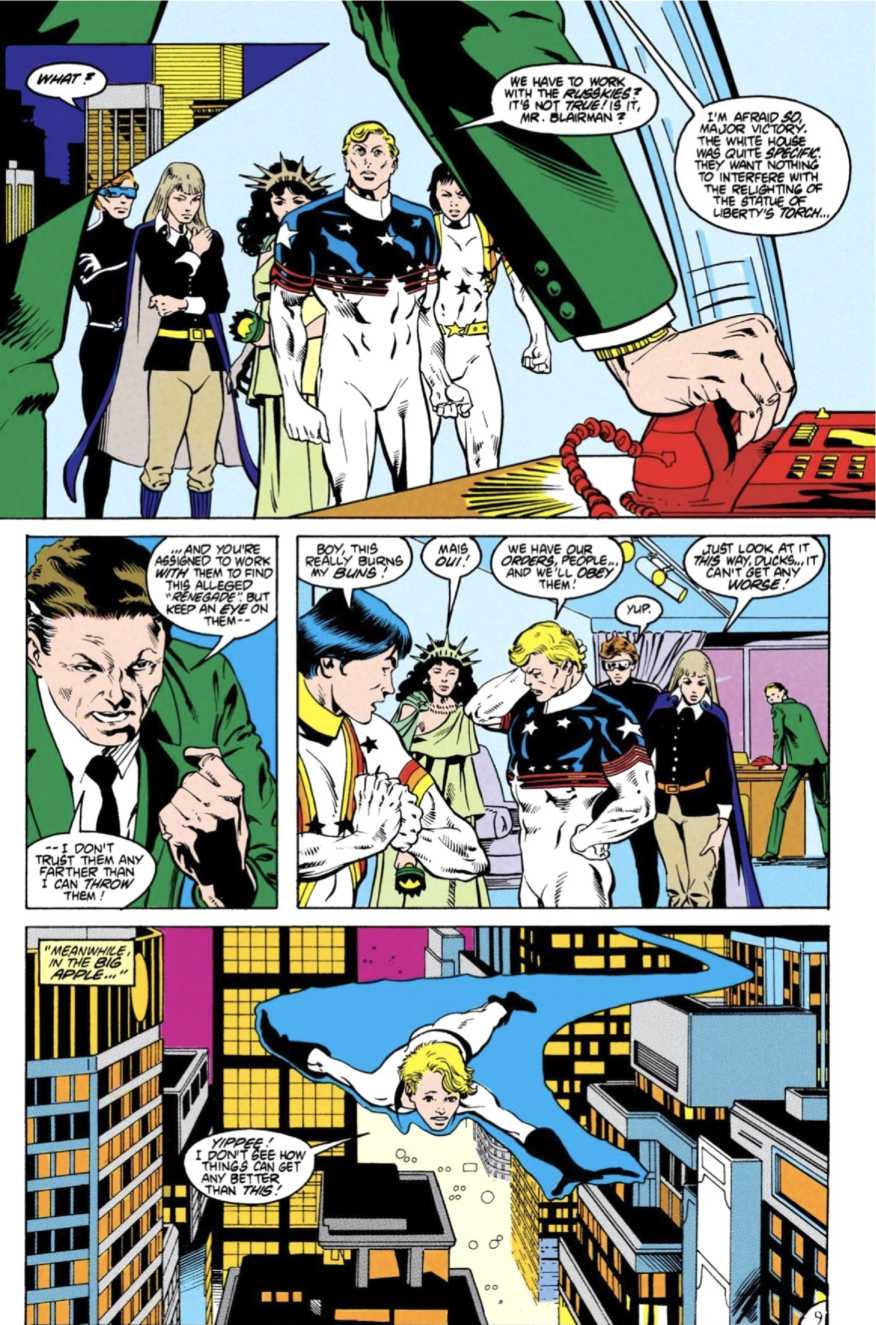
Fig. 8. Frame from the comic book
Images that perform a symbolic function are the building of Moscow State University in the Sparrow Hills and the Kremlin, which represent the USSR, where the alien arrives. Gorbachev is depicted with iconographic accuracy: he personally greets Kilowog with literally open arms and convinces him to use a ring to create a human robot: “...You can create with your ring these amazing machines I’ve heard so much about. We have a project I feel you could help us on... a project to ensure world peace” [6, p. 12]. In the episode where Gorbachev ideologically seduces the alien, he appears to be smiling and prone to friendly hugs. He switches to friendly vocabulary and uses numerous verbal clichés of informal speech: he asks to be called “comrade Gorbachev,” emphasizes that in the USSR all are equal (“We’re all comrades”), and calls Kilowog “comrade Green Lantern.” At the same time, both Kilowog’s line and Gorbachev’s line, the images of the characters themselves – all of this is ironically, and in some moments satirically, embodied. For example, Kilowog is placed in a suite at the Kosmos Hotel in Moscow. The comic book depicts the merits of the room, which amazed the alien: a bathroom, a sink, and a modern-design toilet. It is the comfortable living conditions that made a deep impression on Kilowog, and he wonders why his colleagues in the corps do not like communists so much (Fig. 9).
An important plot conflict emerges and develops in other issues [7; 8], where two of Kilowog’s partners discover that an army of human robots has been created parallel to the Red Rocket and develop a spectacular motif-cliché that unleashes World War III between the USSR and the USA. However, the motif is also satirical. The governments of both countries are victims of the involuntary provocation of the superhero, the green lantern Guy Gardner, who first attacks the USSR, saying that he has always hated the “commie.” Considering it an attack by the United States, Gorbachev orders the launch of nuclear missiles. The above issues give close-ups of the leaders of the states, consistently raising the level of combat readiness of their armies, limited to mutual psychological attack.
The speech duel between the leaders of the superpowers is also shown ironically. Reagan uses speech clichés from Hollywood movies: “Two can play that game!”; “I knew this day would come! I always knew.” However, the style of the images has also been changed. The alternation of closeups of Gorbachev and Reagan with a gradual increase in their size (the final image is a superlarge plan or detail of Reagan’s eye) is a stylization of parallel metric editing, which is used in cinema to create tension in the scene. Gorbachev breaks down and gives the final order for a missile attack, but Green Lanterns quickly destroy the missiles (Fig. 10).
Reagan’s ironic portrayal is also fueled by the verbal characteristics: jokes that the head of the United States allows himself to make in conversation with Green Lanterns. For example, he compares alien defenders to immigrants: “I’ve always supported men who fought for their country – men and women, I mean, and aliens. Of course, if they have their green cards. На, на!” (Fig. 11).
However, President Reagan’s figure, despite its comic and satirical nature, serves as a moral counterweight (the president’s actions essentially demonstrate the normative behavior of a head of state, which is in stark contrast to Gorbachev’s activities). After the departure of Kilowog to the USSR, Reagan calls the Green Lanterns “on the carpet” [7]. Among the claims made by the President of the United States to superheroes is the following: because they are based in the United States, they are obliged to protect the United States. Reagan and the government are presented as frustrated that beings with that kind of power might, as it turns out, choose another state as a location. A debate erupts where superheroes explain to the president that their goal is to protect life in all its manifestations and that Earth politics is insignificant. Reagan then rephrases the claim: if Kilowog transfers power to the Soviets and they create a weapon that America cannot defend against, then America cannot be the guardian of life. Thus, the struggle against communism and the USSR is equivalent to the protection of life in all its manifestations (Fig. 12).
Results. The image of Gorbachev and Russians in the sample of comics is presented in visual, linguistic, and narrative-themed terms as a set of clichés accumulated over decades in different segments of American mass culture (cinema, television, literature, and comics). The earliest clichés date back to the 1930s (movies Comrade X , Ninotchka , and others).
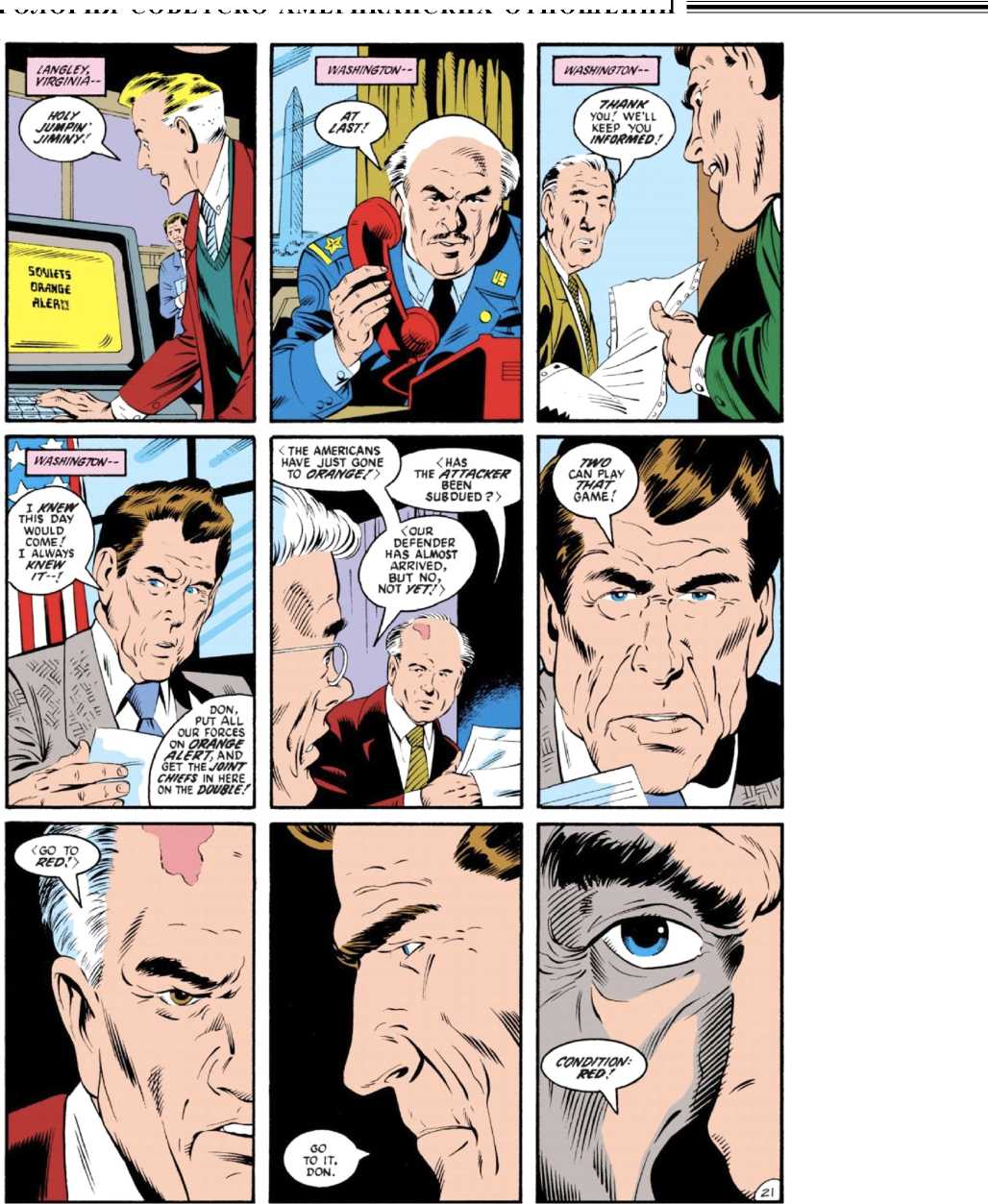
Fig. 9. Frame from the comic book
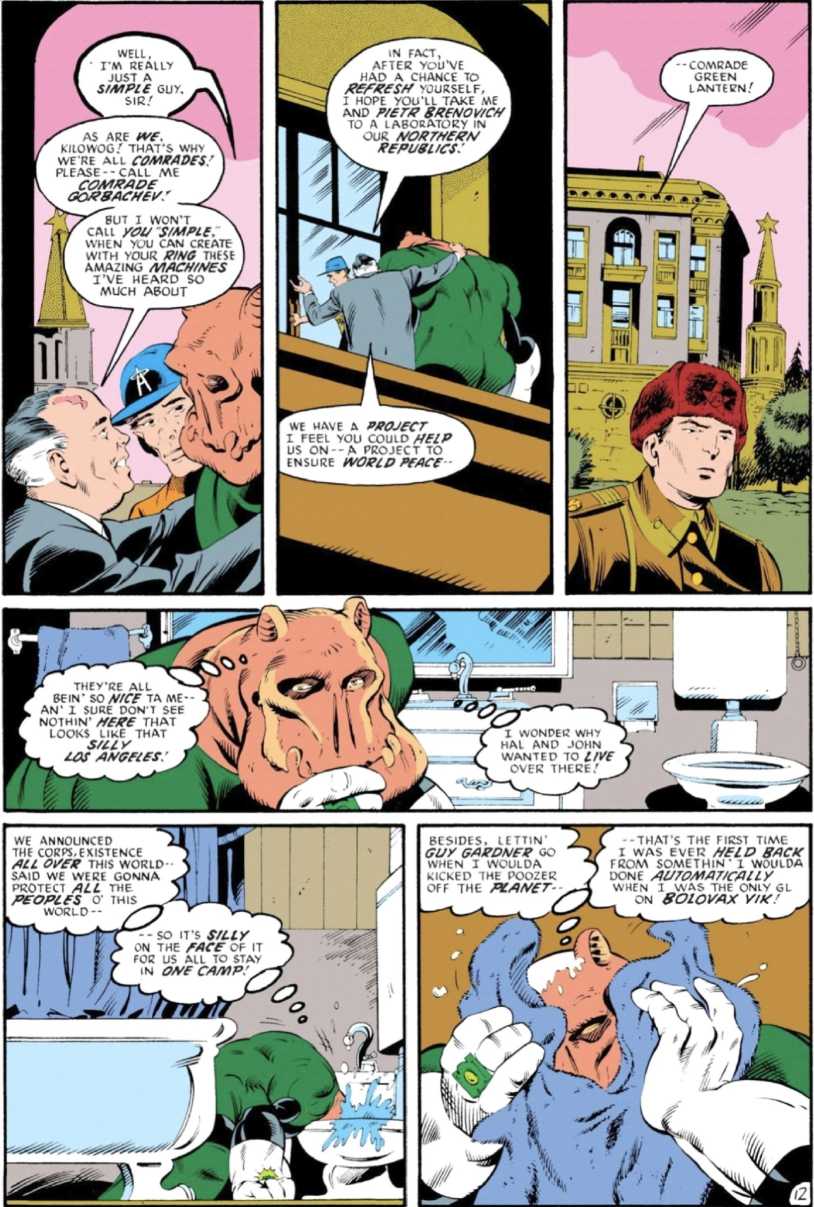
Fig. 10. Frame from the comic book
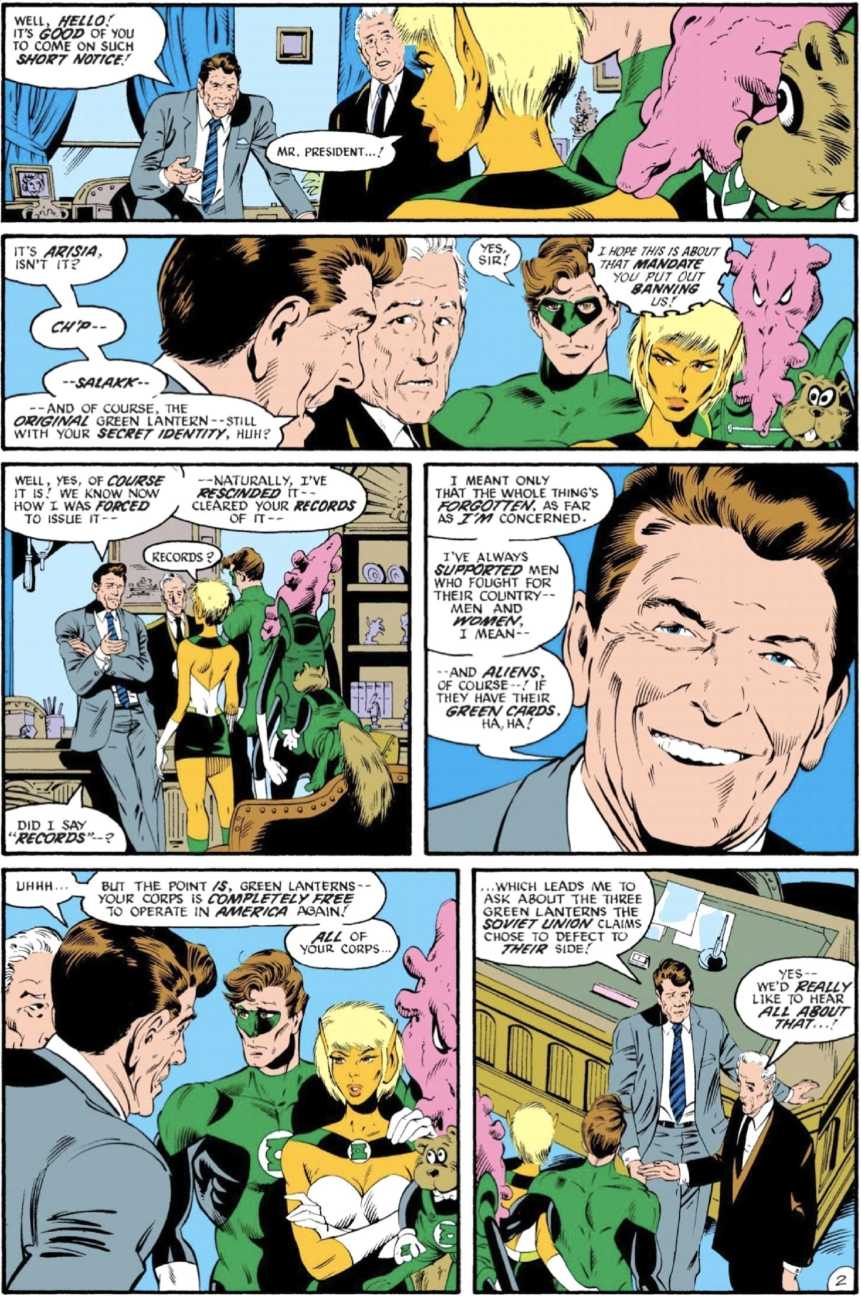
Fig. 11. Frame from the comic book
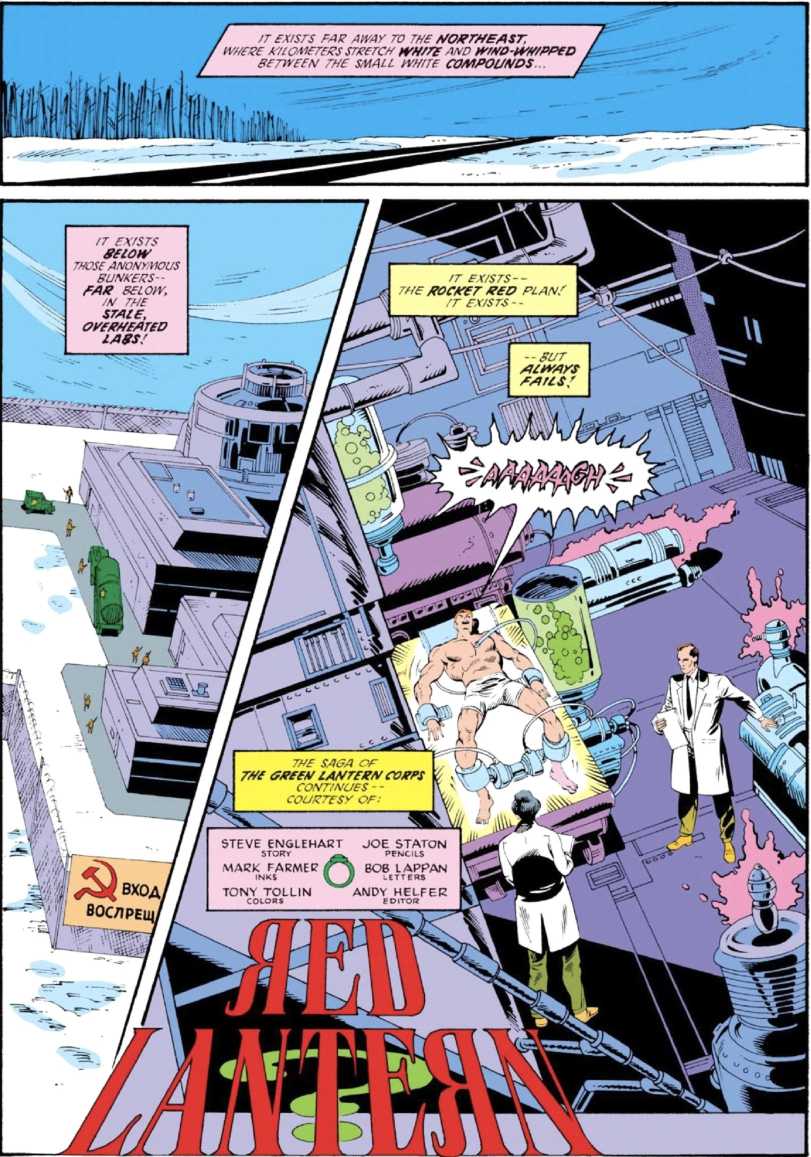
Fig. 12. Frame from the comic book
In contrast to the criticism of Reagan and the U.S. government, the targeted, detailed, subject-oriented criticism of Gorbachev, the Soviet regime, and communist ideology is less relevant to the American reader because it is implemented through clichés. Since this fact is obvious and does not require argumentation, it can be stated that the image of “Russian” communists and of the “Red Menace” in comics is primarily spectacular and entertaining. The images of Russians are realized not through the actual political agenda but through citation, stylization, and the use of literary tropes (grotesque, ironic, parody), which suggest that the target audience understands the old clichés. In this regard, it is indicative that detailed images of “Russians,” the USSR, and Gorbachev appear in the series that were resumed in 1980 after a long publishing pause ( The Outsiders , The Batman , and The Green Lantern Corps ).
Among the actual, individualized, and specific features of Gorbachev (in addition to the obvious, iconic similarity), it is possible to distinguish speech characteristics and a set of actions as the plot of the comic develops. In general, the figure of Gorbachev, unlike the figure of Khrushchev, can be defined as the leader of the state, embodying the ideal of Niccolò Machiavelli’s The Prince . Gorbachev, in the reviewed comics The Outsiders and The Green Lantern Corps , is shown as a ruthless, calculating politician, an experienced strategist, and a skilled diplomat. The authors of the comics do not perceive him as a sole ruler like Khrushchev [26]. In this regard, an illustrative example from the comic book The Green Lantern Corps shows how the Soviet leader communicates with his subordinates at various levels, starting with the military and ending with diplomats.
From the point of view of iconography, a number of ways of depicting Gorbachev in comics correlate with the methods of representing Reagan: his facial expression, behavior, and way of dealing with the interlocutor change quickly, depending on the logic of communication with a particular character ( The Green Lantern Corps ).
Some comics indirectly emphasize the strategic superiority of the USSR leader over American superheroes. In other words, it can be formulated as a criticism of American society and superheroes (the tendency to clichés and stereotypes of the past are demonstrated, in particular, by the members of the Force of July) through collisions with Gorbachev ( The Outsiders ).
The emergence of a realistic character in the image of Gorbachev suggests the expansion of cultural ties between the USSR and the USA, a well-known social demand of the target audience, which was dissatisfied with completely stereotyped images of the leaders of the USSR and the country itself as they were presented in the 1960s. Evidence of this can be seen indirectly through scenes in which a Russian spy describes the features of the political system of the USSR and, more importantly, attracts an alien. It can be said that the criticism of the Soviet system is not presented here through unambiguous denial but through artistic argumentation – the alien, having passed through the tests, is ultimately disappointed by the Soviet political system.
Gorbachev’s image in the comics reflects the changes of the USSR and the Soviet leader in American society [19, pp. 211-290]. The research findings will make it possible to further study this issue and draw the most complete and reliable picture of the impact of the comic book industry on the culture, society, and international relations of the United States.
NOTE
-
1 The article was written with the financial support of the Russian Science Foundation within the framework of the scientific project No. 22-18-00305 dated 05/18/2022 (No. 16/22 RNF) “Images of the enemy in the mass culture of the Cold War: content, modern reception and use in symbolic politics of Russia and the United States”. RNF Grant (Herzen University, Saint Petersburg).
Статья написана при финансовой поддержке Российского научного фонда в рамках научного проекта № 22-18-00305 от 18.05.2022 (вн. № 16/22 РНФ) «Образы врага в массовой культуре Холодной войны: содержание, современная рецепция и использование в символической политике России и США». Грант РНФ (РГПУ им. А.И. Герцена, г. Санкт-Петербург).
Список литературы The USSR state leader in the U.S. superhero comic strips in the 1980s: constructing and broadcasting stereotypes about “Russians” in the historical context of the cold war
- Adventures of Superman. They Call Him Dr. Stratos, 1987, August, no. 431.
- Costello M.J. Secret Identity Crisis: Comic Books and the Unmasking of Cold War America. Bloomsbury Academic & Professional, 2009. 289 p.
- Dittmer J. Captain America’s Empire: Reflections on Identity, Popular Culture, and Post-9/11 Geopolitics. Annals of the Association of American Geographers, 2005, no. 95 (3), pp. 626-643. DOI: 10.1111/j.1467-8306.2005.00478.x
- Dmitrieva D. Vek supergeroev: istoki, istoriya, ideologiya amerikanskogo komiksa [The Age of Superheroes: Origins, History, Ideology of American Comics]. Moscow, Izoteka Publ., 2015. 317 p.
- Petrov D., Yasenchak M.A. et al., eds. 200 let rossijsko-amerikanskih otnoshenij: nauka I obrazovanie [200 Years of Russian-American Relations: Science and Education]. Moscow, OLMA Media Grupp, 2007. 397 p.
- The Green Lantern Corps, 1987, January, no. 208.
- The Green Lantern Corps. Red Dawn, 1987, February, no. 209.
- The Green Lantern Corps. Making the World Safe for Democracy, 1987, March, no. 210.
- Hirsch P.S. Pulp Empire: The Secret History of Comic Book Imperialism. Chicago, University of Chicago Press, 2021. 344 p.
- Holt M.I. Cold War Kids: Politics and Childhood in Postwar America, 1945–1960. University Press of Kansas, 2014. 224 p.
- Is No More the Outsiders, Just the People’s Heroes, 1986, August, no. 10.
- Kazyuchits M.F. Formirovanie obraza F. Kastro v kinodokumentalistike SShA i SSSR pervoj poloviny 1960-h godov [Creating the Image of Fidel Castro in the USA and the Soviet Documentary Films in the First Half of the 1960s]. Novyj istoricheskij vestnik [The New Historical Bulletin], 2023, no. 2, pp. 120-139. DOI: 10.54770/20729286_2023_2_120
- Krensky S. Comic Book Century: The History of American Comic Books. Twenty First Century Books, 2007. 112 p.
- Kukkonen K. Contemporary Comics Storytelling. Lincoln, London, University of Nebraska Press, 2013. 232 p.
- Makklaud S. Ponimanie komiksa [Understanding Comics]. Moscow, Beloe Yabloko Publ., 2016. 216 p.
- Mohova E.M. Syuzhetnaya struktura amerikanskogo komiksa 1960–1970-h godov [The Plot Structure of the American Comic Strip of the 1960s–1970s]. Vestnik RGGU. Seriya «Literaturovedenie. Yazykoznanie. Kulturologiya» [Bulletin of the Russian State University of Humanities. The Series “Literary Studies. Linguistics. Cultural Studies”], 2019, no. 4, pp. 142-156. DOI: 10.28995/2686-7249-2019-4-142-156
- Morrison G. Superbogi: Kak geroi v maskah, udivitelnye mutanty i bog Solnca iz Smolvilya uchat nas byt schastlivymi [Supergods. What Masked Vigilantes, Miraculous Mutants and a Sun God from Smallville Can Teach Us About Being Human]. Moscow, Azbuka-Attikus Publ., Kolibri Publ., 2019. 572 p.
- Nangimah M. The Cultural Repertoire of Recontextualized Superhero in the Avengers Sequels. EduLite Journal of English Education Literature and Culture, 2021, no. 6, pp. 353-368. DOI: 10.30659/e.6.2.353-368
- Zhuravleva V.I., Pavlenko O.V., Pechatnov V.O. et al. Okonchanie holodnoj vojny v vospriyatii sovremennikov i istorikov, 1985–1991 [The End of the Cold War in Representations of Its Contemporaries and Historians 1985–1991]. Moscow, Izd. centr HUUE, 2021. 299 p.
- The Outsiders. Pawns of the Bad Samaritan, 1986, January, no. 3.
- The Outsiders. Pawns of the Bad Samaritan, 1986, January, no. 4.
- The Outsiders ...and The Rockets’ Red Glare, 1988, September, no. 23.
- Bobrowska O., Bobrowski M., Zmudziński B., eds. Propaganda, Ideology, Animation. Kraków, AGH University of Science and Technology Press, 2019. 256 p.
- Riabov O., Riabova T. Images of Urban Space in Constructing the Cold War Enemy: American Skyscrapers in Soviet Animation. Studies in Russian and Soviet Cinema, 2021, no. 15, pp. 1-17. DOI. 10.1080/17503132.2021.1905792
- Shaw T., Youngblood D. Cold War Sport, Film, and Propaganda: A Comparative Analysis of the Superpowers. Journal of Cold War Studies, 2017, vol. 19, no. 1, pp. 160-192.
- Sputnitskaya N.Y. Obraz vraga i metafory Holodnoj vojny v kinoskazke SSSR i geroicheskom komikse SShA 1960–1963 godov [The Image of the Enemy and the Metaphors of the Cold War in the Soviet Cinema Tales and the US Heroic Comics (1960– 1963)]. Novyj istoricheskij vestnik [The New Historical Bulletin], 2023, no. 2, pp. 100-119.
- Tsyrkun N. Vselennaya supergeroev: amerikanskij kinokomiks: istoriya i mifologiya [Superhero Universe: American Film Comics: History and Mythology]. Moscow, Yekaterinburg, Kabinetnyj uchenyj Publ., 2020. 319 p.
- Ryabov O.V., Belov S.I., Davydova O.S., Kubyshkin A.I., Ryabov D.O., Ryabova T.B., Smirnov D.G., Sputniczkaya N.Yu., Yudin K.A. «Vrag nomer odin» v simvolicheskoj politike kinematografij SSSR i SShA perioda holodnoj vojny [“Enemy Number One” in the Symbolic Policy of the Cinematographies of the USSR and the USA During the Cold War]. Moscow, Aspekt Press Publ., 2023. 397 p.
- Willmetts S. Quiet Americans: The CIA and Early Cold War Hollywood Cinema. Journal of American Studies, 2013, vol. 47, no. 1, pp. 127-147.
- Zhuravleva V.I. The Cuban Missile Crisis and the Nuclear Threat in Soviet and American Cartoons: One Story in Two Representations. Novyj istoricheskij vestnik [The New Historical Bulletin], 2023, no. 2, pp. 76-99. DOI: 10.54770/20729286_2023_2_76

